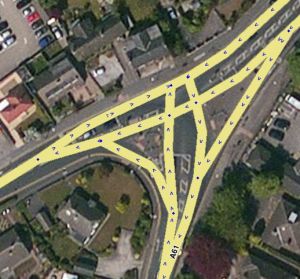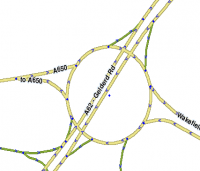Introduction
| This forms part of UK Editing Best Practice. Editor are encourage to follow these guidelines. |
Historically, junctions have been mapped simplistically with a focus on clear instructions. Waze is now encouraging more accurate, true-to-life mapping now that we have tools such as lane guidance, paths, and junction boxes to ensure correct instructions. This makes it easier for users to follow, allows for more accurate GPS snapping and gives better control over closures. Please read the Global Junction Style Guide for a comprehensive guide on editing junctions in general.
Junctions
T-junctions, crossroads, and most junctions are usually best mapped as single 2-way segments connected with a single 2-way segments that are connected with a single node. Complex junctions that include restrictions or large (distinct) turn lanes may benefit from a more complicated layout.
The original UK map import , know as the UK basemap, had a lot of junctions mapped as split one-way roads due to little more than some painted chevrons in the middle of the road. This is completely unnecessary, and any remaining should be simplified where possible.
 |
 |
Keep left / keep right instructions
The addition of KL/KR instructions should only be included under certain lane drop conditions. A lane drop is when one or more lanes of the main carriageway separate off onto a junction. Extra lanes which appear and for which you have to cross a dotted line to reach are not lane drops.
- If there is no lane drop, there should not be a KL/KR
- If there is 1 drop lane and 1 continuing lane, there should be a KL/KR
- If there is 1 drop lane and 2+ continuing lanes, there may be a KL/KR if you cannot easily rejoin the main carriageway, having accidentally left via the drop lane
- If there is 1 drop lane and 2+ continuing lanes, there should be a KL/KR if the continuation of the main carriageway is a different road. Example: end of a Motorway continuing as an A road
- Reasoning: drivers often would like an indication that the road is changing.
- If there are 2+ drop lanes, you should have a KL/KR
- Reasoning: if there are 2 drop lanes and you've accidentally kept to the left, correcting your mistake involves crossing another lane of possibly faster traffic.
The position of the KL/KR junction is also important. The general rule is to have the junction at the 0-mile point - the point at which the distance countdown on the signs reaches 0 - normally a gantry. The problem is that drop lanes are often quite long. Whilst you should be in the correct lane at the 0-mile mark, most drivers change lanes much later than that. It can also cause problems if any splits occur after the first one. You may get a second KL/KR instruction whilst it's still possible to change lanes from the first split.
- The KL/KR split should normally be at the 0-mile point
- If there is an instruction of any sort except roundabout within 1 km after the separation point (the point at which a solid white line separates the drop lane(s)) in either direction, then the KL/KR junction should be at the separation point instead of the 0-mile point.
- All lane drop junctions should be mapped with Lane Guidance
Roundabouts
Most roundabouts can be mapped with single 2-way segments for each connecting road. If there is a significant distance between the entry and exit segments (see the GPS layer for guidance), then they should be mapped with a Y shape. Doing this may adversely affect the instructions (giving exit numbers rather than straight/left/right) (see Roundabout Angles). If you think directions rather than exit numbers would be most suitable, a Junction Box (L4+ only) can be added around the roundabout with each turn instruction overridden on each path (even U-turns.)
Small and mini-roundabouts should be drawn as large as possible. Mini-roundabouts, those that are painted only, should be drawn with a radius of at least 20 feet (6m) or it may not be easily visible on the App, so aim to get them close to this size if you can. This may mean drawing it larger than the road itself. Small roundabouts, those with a kerb or physical centre, should be drawn with a minimum radius of 33 feet (10m) to ensure it can be used by the routing server for U-turns.
| You can read more in depth on Roundabouts in the Global Wiki pages. |
New roundabouts
After drawing a new roundabout, it is important to change the road type to that of the highest connecting road (except Motorway) and set the address. To aid navigation instructions, roundabouts should not be given a Street name. If the roundabout does have a proper, signposted name, then this can be mapped using an Area Place, with the category Junction/Intersection, that fills the centre of the roundabout.
Common issues with roundabouts
- If a roundabout does not have — — — dashed line through the center of its segments, then it is not a proper roundabout but a group of 1-way segments. The client will give keep left and keep right instructions instead of take the nth exit. These junctions should to be deleted and redrawn. Note: If a single segment of a roundabout is selected the info panel will include a button to Select entire which will select all segments of that roundabout.
- If two entry and exit segments share the same junction node on the roundabout, the exit will not be counted when entering at that junction, instructions will then give the wrong exit count. Entry and exit segments should always be connected via separate junctions.
- Sometimes the client will say "Take the 0th exit" for a roundabout. This is often caused by an invisible node on or within the junction, and can only be repaired by deleting and rebuilding the entire roundabout.
- Roundabouts with a radius of 10m or less won't be used for U-turns in a Waze route (this is a country specific configuration).
Special roundabouts

Hamburger roundabout
Sometimes a roundabout will get modified to change its shape and function, such that it is no longer a simple a roundabout.
One such example is the Hamburger Roundabout, where the main carriageway goes straight through the middle of the junction. This should be drawn as if the main road was an over pass, with short ramps connecting it to the roundabout. The example here is near M62 Junction 27 (Leeds).
Some roundabouts get modified so much that they can no longer be considered roundabouts at all. This can be seen at M62 Junction 31 (Castleford)
Gyratories
Often confused with roundabouts, Gyratories are typically circular but lack signage identifying them as roundabouts. They should be mapped with one-way segments connecting each entry/exit. This allows us to add lane guidance/paths, which roundabouts do not. Note, though, that Waze will not give at the nth exit instructions. Turn instructions should be controlled like any other junction (turn, KL/KR, exit).
Triangular junctions

We have quite a lot of triangle junctions in the UK. Some of them are so small they have nothing more than a few square metres of grass in the middle and can usually be simplified into T-junctions.
If they're left as triangles, they can be problematic. For any route through the junction, there are 2 possibilities: the "sensible" route following one side of the triangle; and the "silly" route following 2 sides. Because the triangles generally aren't very big, GPS accuracy isn't good enough to distinguish which route a driver actually takes. So if Waze decides a silly route is faster, then for most drivers who ignore it and take the sensible route, Waze will still think they've gone the long way round and reinforce that route.
If a triangle is large enough to be mapped (e.g. has a large amount of grass or a tree on it), then restrict all internal turns to force Waze to use the sensible route through these junctions.
Give-way at cross-roads

Quite often users think they should be instructed to "cross over" or "go straight-on" when they encounter a give-way or stop sign at a cross-road junction. As there's no turn involved, by default Waze will give no instruction.
Even though Waze has the option to override a turn with a "continue straight" instruction, the UK admins have decided that in most cases, this should not be used. There are far too many of these types of junctions in the UK, so adding them all would be too much of a task. It's the driver's responsibility to be aware of Give Way and Stop signs at junctions. If an editor believes a give-way could benefit from a continue-straight override, please contact the UK champs for approval.
The UK community has suggested that Waze improve this situation by adding to the available instructions. You can vote for this suggestion at this link on UserVoice.